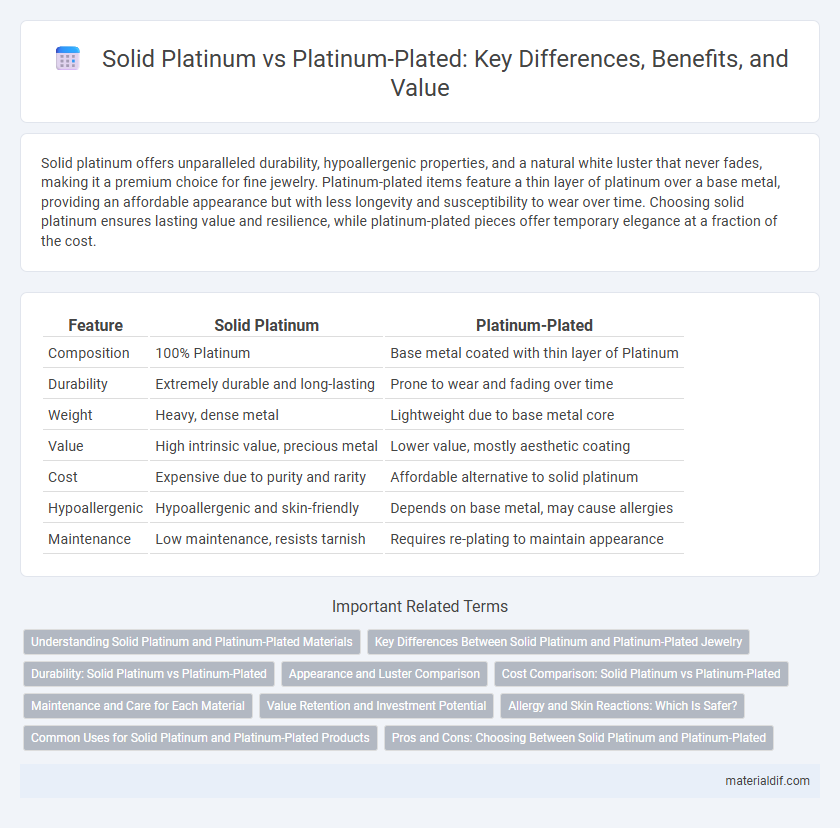Solid platinum offers unparalleled durability, hypoallergenic properties, and a natural white luster that never fades, making it a premium choice for fine jewelry. Platinum-plated items feature a thin layer of platinum over a base metal, providing an affordable appearance but with less longevity and susceptibility to wear over time. Choosing solid platinum ensures lasting value and resilience, while platinum-plated pieces offer temporary elegance at a fraction of the cost.
Table of Comparison
| Feature | Solid Platinum | Platinum-Plated |
|---|---|---|
| Composition | 100% Platinum | Base metal coated with thin layer of Platinum |
| Durability | Extremely durable and long-lasting | Prone to wear and fading over time |
| Weight | Heavy, dense metal | Lightweight due to base metal core |
| Value | High intrinsic value, precious metal | Lower value, mostly aesthetic coating |
| Cost | Expensive due to purity and rarity | Affordable alternative to solid platinum |
| Hypoallergenic | Hypoallergenic and skin-friendly | Depends on base metal, may cause allergies |
| Maintenance | Low maintenance, resists tarnish | Requires re-plating to maintain appearance |
Understanding Solid Platinum and Platinum-Plated Materials
Solid platinum consists of pure platinum metal, typically 95% or higher purity, offering exceptional durability, resistance to tarnish, and a naturally white luster that lasts a lifetime. Platinum-plated items feature a thin layer of platinum bonded to a base metal such as silver or brass, providing a similar appearance but with significantly lower cost and diminished wear resistance over time. Understanding the distinction highlights solid platinum's superior value and longevity compared to platinum plating's affordability paired with a higher risk of fading or peeling.
Key Differences Between Solid Platinum and Platinum-Plated Jewelry
Solid platinum jewelry consists entirely of pure platinum, offering superior durability, hypoallergenic properties, and a naturally lustrous finish. Platinum-plated jewelry features a base metal coated with a thin layer of platinum, which can wear off over time and is less resistant to scratches and tarnish. The key differences lie in longevity, maintenance, and overall value, with solid platinum providing a lasting investment compared to the more affordable but temporary appeal of platinum-plated pieces.
Durability: Solid Platinum vs Platinum-Plated
Solid platinum is inherently more durable than platinum-plated items due to its dense, corrosion-resistant nature, maintaining its appearance and structural integrity over time. Platinum-plated pieces, coated with a thin layer of platinum over a base metal, are prone to wear and tarnishing as the plating gradually erodes through regular use. The thickness and quality of solid platinum provide superior resistance to scratches, dents, and discoloration when compared to the limited longevity of platinum plating.
Appearance and Luster Comparison
Solid platinum boasts a naturally bright white luster that remains untarnished over time, maintaining its classic, elegant appearance with minimal maintenance. Platinum-plated jewelry features a thinner layer of platinum over a base metal, which can wear off, revealing the underlying metal and causing discoloration or dullness. The solid form's dense structure provides a more consistent shine, whereas platinum-plated items may lose their luster faster due to surface wear and exposure.
Cost Comparison: Solid Platinum vs Platinum-Plated
Solid platinum, composed of 95% pure platinum, commands a significantly higher price due to its rarity and durability, often costing thousands of dollars per ounce. In contrast, platinum-plated jewelry features a thin layer of platinum over a base metal, resulting in a substantially lower price point, sometimes less than one-tenth the cost of solid platinum pieces. The initial investment in solid platinum reflects its long-lasting value and resistance to tarnish compared to the more affordable but less durable platinum-plated alternatives.
Maintenance and Care for Each Material
Solid platinum requires minimal maintenance due to its durable and non-tarnishing nature, needing only periodic cleaning with mild soap and water to maintain its natural luster. Platinum-plated jewelry demands more careful care because the thin layer of platinum can wear away over time, exposing the base metal; avoid abrasive cleaners and store pieces separately to prevent scratching. Regular inspection and professional re-plating are essential for platinum-plated items to preserve their appearance and prevent damage.
Value Retention and Investment Potential
Solid platinum offers superior value retention due to its high purity and intrinsic metal content, making it a reliable long-term investment compared to platinum-plated items. Platinum-plated products consist of a thin layer of platinum over base metals, resulting in minimal investment potential since their value heavily depends on the underlying material rather than the precious metal coating. Investors seeking durable asset growth favor solid platinum for its consistent market demand, resistance to corrosion, and standardized pricing based on weight and purity.
Allergy and Skin Reactions: Which Is Safer?
Solid platinum is hypoallergenic and ideal for sensitive skin, as it contains no alloys that typically cause allergic reactions, making it a safer choice for those with metal allergies. Platinum-plated jewelry may cause skin irritation or allergic responses due to the base metals beneath the thin platinum layer, which can become exposed over time. For long-term wear without skin reactions, solid platinum offers superior safety compared to platinum-plated alternatives.
Common Uses for Solid Platinum and Platinum-Plated Products
Solid platinum is commonly used in high-end jewelry, medical instruments, and industrial applications due to its durability, hypoallergenic properties, and resistance to tarnish. Platinum-plated products are frequently found in fashion accessories, costume jewelry, and household items where the look of platinum is desired without the high cost. The choice between solid platinum and platinum-plated materials depends on the application's need for longevity, investment value, and budget constraints.
Pros and Cons: Choosing Between Solid Platinum and Platinum-Plated
Solid platinum offers exceptional durability, hypoallergenic properties, and long-lasting value, making it ideal for fine jewelry that withstands daily wear. Platinum-plated items provide an affordable alternative with a similar appearance but tend to wear off over time, revealing the base metal and requiring replating. Choosing between solid and plated platinum depends on budget constraints, desired longevity, and maintenance willingness.
Solid Platinum vs Platinum-Plated Infographic

 materialdif.com
materialdif.com